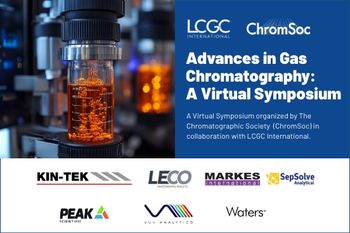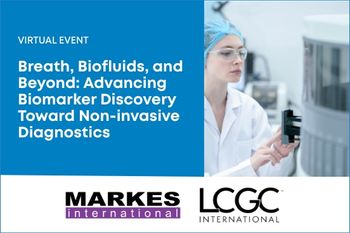
Recent Advances in Solid-Phase Microextraction, Part II: Bio-SPME

Bioanalysis with SPME has advanced greatly over the past decade.
One year ago, this column took a look at recent developments in solid-phase microextraction (SPME), especially approaches to increase the sorbent amount or surface area. This month, we will focus more specifically on approaches amenable to bioanalysis developed in the past decade. Important considerations include compatibility with biofluids and -omics applications, in vivo sampling, high throughput, and mass spectrometric analysis.
Since the advent of solid-phase microextraction (SPME) nearly 30 years ago, the technique has been used in several innovative manners. The selectivity provided by the stationary phase provides cleaner analytical extracts, the lack of organic solvent is touted as a green chemistry advantage, and perhaps most interestingly, the configuration of the SPME device leads to several unique applications. In the fiber mode, injection directly into a chromatograph, without sample dilution, is common. With the thin-film approach, coupling with atmospheric ionization mass spectrometry (MS) can be accomplished. In March, 2018, we looked at the current state of SPME (1). However, we purposely omitted one important and growing area, bio-SPME, or the application of SPME approaches to the direct sampling of biological systems for subsequent analysis. The technique of bio-SPME, with an emphasis on in vivo analysis, is the topic of this month's installment of "Sample Prep Perspectives."
Conventionally, ultrafiltration or microdialysis techniques are used in the separation or sample preparation step for in vivo analysis, that is, for direct, dynamic analysis of the chemistry occurring in a live system. Using an SPME approach is less expensive, faster, and simpler than the traditional methods. Perhaps most importantly, bio-SPME reduces animal use, especially since repeated measurements on the same animal can be made. However, with in vivo measurements, common sample preparation steps like agitation, protein precipitation, or pH adjustment cannot be performed. Bio-SPME is uniquely qualified for real-time in vivo studies of metabolite fluxes. The clean samples (that is to say, selectivity) afforded by bio-SPME keeps chromatography and MS systems cleaner, allowing greater uptime and sample throughput, while minimizing system maintenance issues. A final challenge for SPME bioanalysis, but one which SPME is uniquely suited to address, is the small (sometime tens of microliters or less) sample volumes. The ultimate goal in bio-SPME is to obtain a representative sample with minimal disturbance of the biological system.
Device Configuration
Especially due to the small sample volumes previously mentioned, the configuration of the bio-SPME device is a key feature. In some instances, valuable information about biochemical processes can be obtained by sampling the system headspace. In this case, conventional SPME devices can be used. But, when small volumes of blood, urine, or other biofluids, even single cells, are directly sampled, the design of the bio-SPME device must be considered. Two means, using nonferrous-metal tips (stainless steel and nitinol), as opposed to the conventional fused silica coated, for example, with polypyrrole (PPy), or using coated-blade spray (CBS) devices, are presented in the recent literature (2). In the first case, the tip of a small metal fiber is coated with PPy stationary phase, which is then immobilized. This mini-fiber then can be used for sampling using a standard immersion method, and can be desorbed and characterized with chromatography-MS or directly using nano-electrospray ionization (nano-ESI)-MS. In the CBS approach, the sample is spotted onto a flat (blade) configuration of SPME, which can then be used as the solid-substrate for ESI-MS. This research group (3) also recently presented an in-tube SPME approach for the extraction and analysis of single-drop samples (those samples with volumes less than 2 mL). The stationary phase coating was inside a medical grade spiral needle, which provided a large surface area for analyte adsorption, resulting in rapid equilibrium times (as low as 3 min total analysis time, with in-tube SPME directly connected with MS/MS), with superior analytical sensitivity and reproducibility. Thin film technology, such as the CBS type referred to earlier, has a large coated surface area to thin coating ratio, which provides improved sensitivity. This approach was combined with plastic (polybutylterephthalate [PBT]) for disposable, single-use applications (4). PBT is available in medical grade, with well-characterized chemical resistance for bioanalysis applications, and is inexpensive. When used with polyacrylonitrile (PAN), the device was compatible with a range of biofluids, such as urine, plasma, and whole blood. With a hydrophilic-lipophilic balance (HLP) coating in combination with PAN, no absolute matrix effects were reported. With single use devices, sample carryover concerns in drug-testing and forensic applications are minimized. (As an aside, regular readers will know that one theme of my research is green chemistry. Thus, we are particularly pleased with the avoidance of hydrochloric acid-etching in the fabrication of these bio-SPME devices).
As stated above, ESI typically is used in coupling bio-SPME with MS, especially with the CBS configuration. This seems logical, given the concurrent maturation of bio-SPME and ESI, paper spray, and related ionization techniques. A more versatile approach to the direct coupling of bio-SPME with MS was published just last year (5). A microfluidic open interface (MOI) features a flow-isolated desorption region with a 7-mL chamber connected to the ion source. The researchers assert that any ion source with reliable and constant vacuum suction is compatible with the MOI. This would include ESI, atmospheric-pressure chemical ionization (APCI), and inductively coupled plasma ionization. Desorption times of 5 s and limits of quantitation below the nanogram per milliliter range were noted. The MOI appears to be a derivation of the previously reported open port probe (OPP) for the direct coupling of bio-SPME with APCI-MS (6). The OPP required minimal alteration to the MS inlet, and featured solvent desorption followed by aspiration with a nebulizer gas. Sensitivity, simplicity, speed, and throughput were touted as advantages of this approach, especially when combined with multiple-reaction monitoring (MRM). For example, the drug testing requirements of the World Anti-Doping Agency (WADA) were met, using extraction-desorption times of just over 5 min and sample volumes of 300 µL.
Stationary Phases
Just as the column is the heart of a chromatograph, the stationary phase is the heart of SPME. This is where the extraction and sample enrichment occurs, and what provides the selectivity advantages. In addition to the conventional requirements of an SPME phase (primarily, immobilized onto the SPME platform; amount, type, and thickness compatible with the analysis needs), bio-SPME phases may possess molecular recognition features and may be used in vivo. For in vivo applications, a biocompatible stationary phase coating should possess two primary features. First, the coating should be nonreactive with the biological system to minimize toxic effects, clotting, infection, or other adverse impacts. Secondarily, the coating should be designed to minimize adsorption of macromolecules, such as proteins or polysaccharides, or any of a number of other compounds inherent to the sample, but which may provide interferences, obscure adsorption and desorption, or minimize analyte detection.
Vuckovic and associates (7) presented biocompatible phases as part of their review of bioanalysis with SPME. The phases they identified, and some meaningful attributes, include:
- Polydimethylsiloxane (PDMS): commercially available, and widely used. Long equilibration times, and polar compounds are not easily adsorbed, due to hydrophobicity of PDMS.
- Polyacrylonitrile (PAN): robust with high extraction efficiency, can be autoclaved, has broad applicability.
- Polyethylene glycol (PEG): short equilibration times, high sensitivity, cannot be autoclaved.
- Polypyrrole (PPy): fast equilibration times, can be autoclaved, and can be directly coupled with MS. Limited reproducibility and dynamic range. PPy is the same biocompatible polymer often used in biosensors. It has been claimed (3) that extraction efficiency is improved with a coating of hydrophilic-lipophilic balance material inside the needle of the in-tube approach.
- Restricted access material (RAM): great reproducibility and reusability, long equilibration times, dual functionalities (like hydrophobicity and size exclusion) leads to high selectivity. Alkyl-diol-silica (ADS) is commonly used. RAM stationary phases in bio-SPME are discussed by Mullett and Pawliszyn (8).
- Supelco fibers: series of proprietary fibers with high extraction efficiency and chemical and mechanical stability with long equilibration time.
- Molecular imprinted polymers (MIP): often mixed with affinity-based coatings, superior performance at physiological pH.
- Immobilized antibodies: high affinity and specificity for the complementary antigen.
- Halloysite nanotubes with titanium dioxide (HNTs-TiO2): sol-gel techniques are used to coat the SPME fibers (9). Provide similar results to, and use similar retention mechanism as, carbon nanotubes.
Forty-two different bio-SPME coatings were compared for applicability, with 36 different analytes covering a range of polarities (10). They found that mixed- mode coatings, polar-enhanced polystyrene divinylbenzene, and phenylboronic acid provided the most acceptable results for untargeted metabolomics profiling; that is, when both hydrophilic and hydrophobic metabolites are simultaneously extracted at physiological conditions. The study confirmed that bio-SPME, compared with more traditional approaches to bioanalysis, reduced ion suppression in MS, extracted hydrophobic compounds excluded by ultrafiltration, and increased the range of metabolite screening.
Conclusions
When pusuing the literature cited for this month's installment, it doesn't take an astute observer to determine that the great majority of these references come from the laboratory of Janusz Pawliszyn at the University of Waterloo, with a host of collaborators. As the "father of SPME," Pawliszyn and his associates are continuing to push the envelope in the development of bio-SPME. However, this is not at the exclusion of others. Although specific bio-SPME applications, with the exception of the review cited in the following paragraph, are beyond the scope of this column, both the commercialization of bio-SPME by nearly all vendors of SPME products, and the number of studies uncovered in suitable literature searches, demonstrate that bio-SPME is moving beyond being a niche approach. The ability to contribute to the expanding knowledge in a number of biochemistry, medicinal, and cell biology fields is an attribute of the bio-SPME developments over the past decade.
As part of a three-part review series covering the state of the art of SPME applications in 2015 (11), at least 37 different bio-SPME applications were reported. While most of these dealt with plasma, urine, and whole blood, both inorganic and polar and nonpolar analytes were targeted. Circulating blood provided the first dive into live animal studies. For tissue analysis, bio-SPME compared favorably with tissue removal, microdialysis, and biosensors. The reader is urged to evaluate investigations of their specific interest in this broad field of bioanalysis. Note, however, that each study is moving the field of sample preparation for bioanalysis beyond the current limitations to more common practice, and the coming decade promises to provide more exciting and biologically relevant results.
References
(1) D.E. Raynie, LCGC North Am. 36(3), 166–169 (2018).
(2) H. Piri-Moghadam, F. Ahmadi, G.A. Gomez-Rios, E. Boyaci, N. Reyes-Garces, A. Aghakhani, B. Bojko, and J. Pawliszyn, Angew. Chem. Int. Ed. 55, 7510–7514 (2016).
(3) H. Piri-Moghadam, S. Lendor, and J. Pawliszyn, Anal. Chem. 88, 12188–12195 (2016).
(4) N. Reyes-Garces, B. Bojko, D. Hein, and J. Pawliszyn, Anal. Chem. 87, 9722–9730 (2015).
(5) M. Tascon, M.N. Alam, G.A. Gomez-Rios, and J. Pawliszyn, Anal. Chem. 90, 2631–2638 (2018).
(6) G.A. Gomez-Rios, C. Liu, M. Tascon, N. Reyes-Garces, D.W. Arnold, T.R. Covey, and J. Pawliszyn, Anal. Chem. 89, 3805–3809 (2017).
(7) D. Vuckovic, X. Zhang, E. Cudjoe, and J. Pawliszyn, J. Chromatogr. A 1217, 4041–4060 (2010).
(8) W.M Mullett and J. Pawliszyn, J. Sep. Sci. 26, 251–260 (2003).
(9) M. Saraj, M.T. Jafari, and M. Mossaddegh, Anal. Chim. Acta, 926, 55–62 (2016).
(10) D. Vuckovic and J. Pawliszyn, Anal. Chem. 83, 1944–1954 (2015).
(11) E.A. Souza-Silva, N. Reyes-Garces, G.A. Gomez-Rios, E. Boyaci, B. Bojko, and J. Pawliszyn, TrAC Trend Anal. Chem.71, 249–264 (2015).
ABOUT THE COLUMN EDITOR
Douglas E. Raynie "Sample Prep Perspectives" editor Douglas E. Raynie is a Department Head and Associate Professor at South Dakota State University. His research interests include green chemistry, alternative solvents, sample preparation, high-resolution chromatography, and bioprocessing in supercritical fluids. He earned his PhD in 1990 at Brigham Young University under the direction of Milton L. Lee. Raynie is a member of LCGC's editorial advisory board. Direct correspondence about this column via e-mail to
Newsletter
Join the global community of analytical scientists who trust LCGC for insights on the latest techniques, trends, and expert solutions in chromatography.





